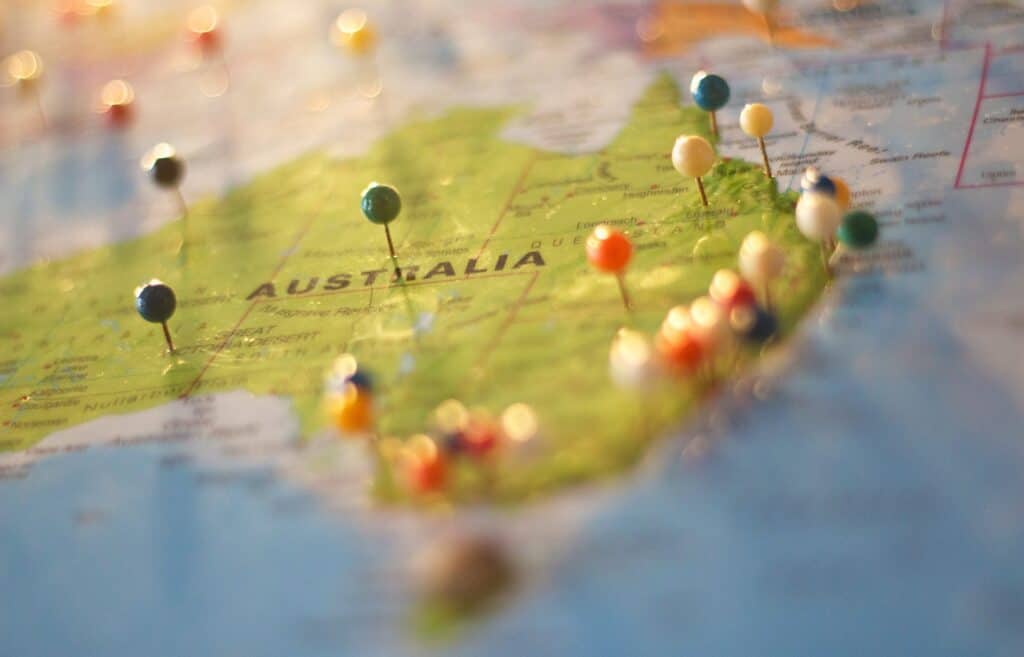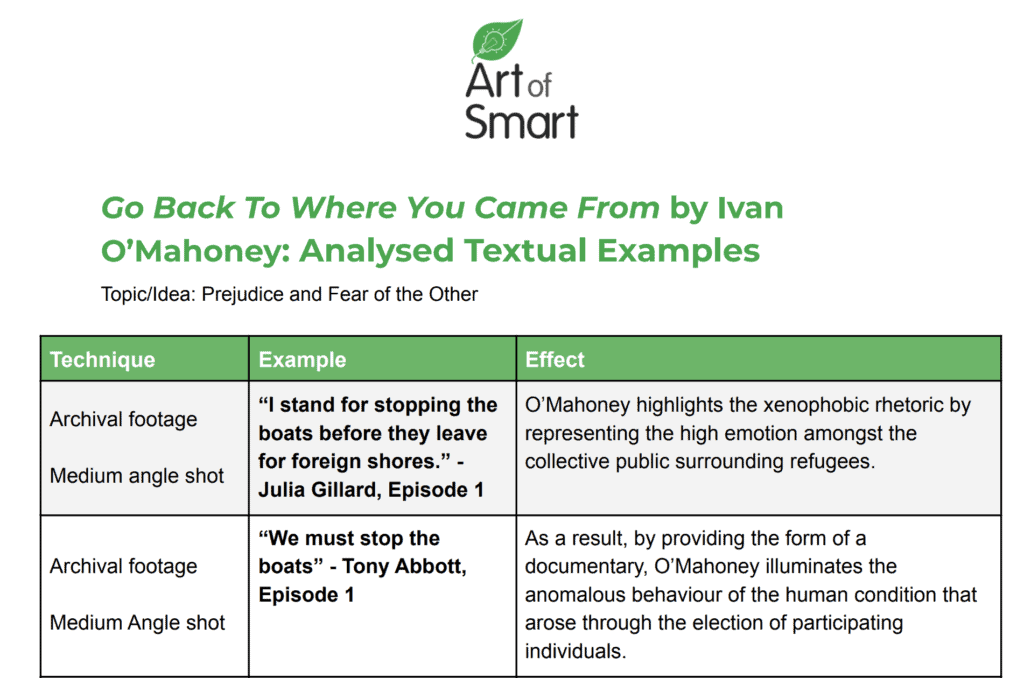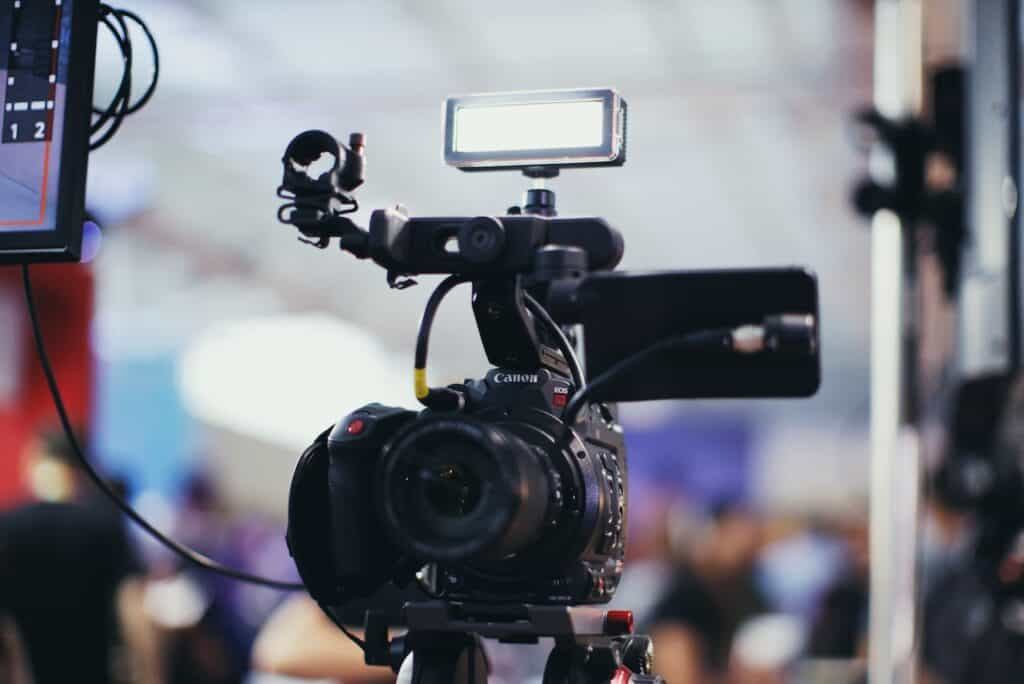Are you currently studying ‘Go Back to Where You Came From’ for HSC English: Common Module, and having trouble decoding the episodes for analysis?
You’ve come to the right place!
We’ve compiled a detailed overview of the key themes/ideas throughout each episode of ‘Go Back to Where You Came From’ (GBTWYCF) as well as a step-by-step of how to analyse the text.
But that’s not all! We’ll also provide a sample analysis table (TEE table) with an exemplar Band 6 paragraph for ‘GBTWYCF’!
We have a lot to get through, so it’s time to ace your analysis of ‘GBTWYCF’. Let’s get started!
Go Back to Where You Came From Summary
Key Participants in Go Back to Where You Came From
Context
Themes Explored in Go Back to Where You Came From
Essay Analysis of Go Back to Where You Came From
How Go Back to Where You Came From Links to Texts and Human Experiences
Go Back to Where You Came From Summary
Content warning: Racism
The reality television/documentary hybrid series directed by Ivan Mahoney focuses on the controversial issue of Australia’s asylum seekers which sparked great debate within its release time.
The show follows 6 participants who collectively express a negative attitude towards refugees and asylum seekers through differing lenses, and are provided with the opportunity to experience a typical refugee journey. Throughout the series, there are many elements that remain true to the collective refugee experience; each character’s representation is portrayed in a particular light.
In doing so, O’Mahoney aims to spark a debate amongst Australian audiences to ignite a more positive attitude towards asylum seekers’ cause.
Episode 1
The series opens with archival footage of the 2010 Christmas Island boat disaster accompanied by numerous news reports in a montage showing the hardship of travelling via boat to Australia as an asylum seeker.
We are then immediately introduced to the voice-over narrator, Colin Friels, explaining the premise of the social experiment, in which six Australian volunteers over 25 days will undergo the reverse journey of refugees travelling to Australia. The six participants are introduced which include Raye, Adam, Raquel, Roderick, Gleny, and Darren alongside the host, Dr David Corlett.
With each participant accepting the challenge without money, phones, or ID — each participant is divided out to interact with former refugees living in Australia.
We meet the Masudi family from Burundi and the Democratic Republic of Congo who Raquel and Raye have dinner and a family of immigrants from Iraq staying in a suburban flat which welcomes all other participants and openly answers any questions about their intentions to live in Australia and their mode of how they got here.
Episode 2
Similar to Episode 1, this episode begins with more archival footage while also providing a recap of the participant’s previous experiences. The core of this episode follows the participants heading to Kuala Lumpur, Malaysia, with Raquel and Raye constantly expressing distasteful opinions on their surroundings, particularly, the cleanliness and disbelief at the number of people.
We are then met with the Chin families, who live amongst one another as they are seeking refuge to escape deportation as a result of religious and ethnic conflict. The VO informs the audience that at 5am daily, the Chin hosts begin working illegally on farms and construction sites, compensated with food for their families — in which the participants begin empathising with their experiences as they compare these working standards to those in Australia.
The participants are also exposed to a midnight raid of the construction site which is suspected of holding refugees with the participants beginning to change their perspective towards the experiences of asylum seekers.
Episode 3
This episode aims to provide a deeper insight into the refugee experience with the participants being crossed between Jordan and Kenya. As the VO, explains the statistics of displacement in Africa, the participants provide their insights — expressing fear amidst the intimidating environment they’re in.
Gleny, Darren, and Adam are in Jordan where they visit a hospital that treats the indiscriminate victims of bombings. The audience is confronted with patients clearly showing their wounds and deformations due to the ongoing attacks happening in the country.
In Kenya, the participants meet Bahati and Maisaa’s relatives in which the family is then shown a video message from Australia which is a crucial turning point for both Raye and Raquel.
The participants continue to travel between Kenya and Congo where they are initially confronted with enhanced security around them. The VO provides an overview of the reality of war in the country.
The participants interact with the women who sing and dance in celebration with their new supporters, which Raye joins in as well too. During the final scenes in Iraq, the participants travel through the streets of Baghdad in armoured US vehicles where they converse with the US two-star General about the security levels of citizens and refugees in Iraq.
The Reunion
Dr Corlett invites the six participants who underwent the social experiment to provide their unique perspectives on their individual experiences in an attempt to see if perceptions had changed. Raye, Darren, Gleny, and Raquel all express a more empathetic opinion on asylum seekers and the refugee experience whilst Adam retains a more neutral response to it.
Key Participants in Go Back to Where You Came From
Raye
Reside in Adelaide Hills which she describes as a ‘Utopia’ until the detention centre was made near her. Her initial opinion on asylum seekers is presented as she states, “I could have gone over there with a gun and shot the lot of them.”
Her role throughout the series is a motherly figure to the other perspectives and a representation of the older patriotic Australians.
Raquel
A young self-justified racist who is unemployed from Western Sydney openly confesses that Sudanese and the ‘Africans’ have taken over the suburb she resides in which is Blacktown.
She consistently expresses her opinion and that she just doesn’t “like black people (…) I guess I am a bit racist, I just don’t like Africans.” Her role throughout the series represents the ‘bogan’ youth Australian.
Gleny
A country singer from Newcastle is introduced as an open-minded ‘hippy’ type. She offers a vastly different perspective to all other participants as she believes that refugees help diversify Australian society, “I think that we have the capacity to take more refugees.”
“I would love to have a refugee come and stay with me, I think detention centres are inhumane.”
Roderick
From Brisbane, is a self-confessed “centre-right, government hater”. He currently acts as the Federal Vice President of the Young Liberals and believes that “We should treat the cause”.
Adam
Born and raised in the Sutherland Shire of Sydney, his occupation as a lifeguard had him working on the day of the 2005 Cronulla Race Riots.
Whilst he admits that the riots were wrong on Australia’s behalf, he still believes that refugees are criminals and is adamant that unnecessary money is being spent on them.
Darren
From Adelaide was a former soldier in the Australian Army. He resides in the suburban part of the city with his Thai wife and their two children.
His initial opinion on asylum seekers is presented as he states that Australia “Needs to send a tougher signal out… People who come here by boat without any documentation should be immediately expatriated”. Darren is a representation of the middle-class, tax-paying Australians
Context of Go Back to Where You Came From
Authors Background
Ivan O’Mahoney is an American director, producer, and screenwriter. His initial career as a lawyer shaped his interest towards journalism as he states, “I got quite frustrated with the fact that I was often representing people who were winning cases because they could afford specialised lawyers. That lead me to look for the next step in my career.”
After completing his postgraduate degree at the Columbia Journalism School he began a new career with CNN which was followed by an eight-year move to the UK where he produced documentaries for Channel 4 News, BBC Current Affairs, and HBO.
O’Mahoney moved to Australia in 2008, where he continued his work as a producer but started to focus more on various socio-political issues. This was seen as he produced for the Australian current affairs show Four Corners as well as Go Back to Where You Came From.
Historical Context
For centuries, Australia has been involved with accepting refugees in seek of resettlement and is now one of the most culturally diverse countries in the world. Amidst the turn of the century in both the 2000s and 2010s, the conversation of immigration and border security became a central focus both politically and socially.
Acting opposition leader at the time, Tony Abbott publicly vowed to ‘stop the boats’ which was supported by prime minister Julia Gillard who stated, “I stand for stopping the boats before they leave foreign shores.” This sparked a nationwide debate on exactly who refugees and asylum seekers are and their motives towards coming to Australia.
There were many opinions put forward by the public towards their disagreement with the sudden influx of asylum seekers who came to the country by boat which included:
- Introducing foreign cultural traditions and values to others, which threatened Australian culture as a result
- Taking jobs
- Receiving a higher welfare payment from the government and Centrelink (higher taxes)
Hence, this debate motivated O’Mahoney to direct ‘GBTWYCF’ who wanted to respond directly to the public confusion and educate the Australian population to provide more empathy towards the issue.
Themes Explored in Go Back to Where You Came From
- Prejudice and fear of the ‘Other’ – Xenophobic attitudes
- Human relationships
- Perspectives towards immigration
- Conflicting culture and class
- Displacement/Acceptance
How to Analyse ‘Go Back to Where You Came From’ in 3 Steps (Essay Analysis)
When writing analysis in essays, it’s important to understand the specific form of the text! With ‘GBTWYCF’ being a reality TV/documentary text the analysis formed should come from film-focused techniques.
Once you’ve been able to dissect particular scenes from the show, this will form the backbone of your paragraphs and your essay!
We’re going to walk you through creating an analysis for ‘Go Back to Where You Came From’ in three simple steps!
Step 1: Choose your example
The most effective way to choose the right example is to make sure you have a strong technique with it. Because this text is specifically a reality TV/documentary, we’d expect film techniques to build the main focus of your analysis which will add a lot more value to your essay.
You can find a comprehensive list of quotes from the Go Back to Where You Came From here!
We have chosen to look at two examples/scenes to illustrate the refugee experience in ‘GBTWYCF’:
Flashbacks of the Christmas Island boat disaster (A scene throughout the series)
and
“We must stop the boats”
Step 2: Identify your technique(s)
When trying to find techniques for your examples, students often get swayed to find the most advanced techniques and miss the importance of using simple yet effective ones to convey a strong piece of analysis.
As this is a film text, try to focus on finding techniques which display a valuable meaning, such as specific camera angles, diegetic/non-diegetic music, narration, etc. Other techniques such as dialogue, are too vague and you’ll find it harder to produce an analysis of value for your essay.
We have identified 4 techniques in the two examples above: Archival footage, Interview, single shot, and pan shot.
It’s always good to have more than one technique for each of your examples as it brings your analysis up a notch!
Step 3: Write the analysis
When you write your analysis, it is important to always prioritise the effect of the technique your example has. You should always make sure that your analysis fleshes out each technique, to ensure that the point you make is clearly communicated to the marker.
For example, O’Mahoney utilises the recurring scene of the Christmas Island boat disaster through the use of archival footage which is integral in highlighting the integrity of the filmmaking process. This further allows audiences to be confronted with the reality of the refugee experience.
As you can see above, the technique has been clearly shown alongside the purpose and its effect on audiences — which is also an important aspect to include in your analysis.
Studying Go Back to Where You Came From for the HSC Common Module: Texts and Human Experiences
Now that we’ve gone through the technical aspects of studying GBTWYCF, let’s now look at how this text is studied in light of the Common Module!
Individual VS Collective
The distinct contrast between the individual and collective experience is seen within the participants and the refugees throughout the series. O’Mahoney distinctly illustrates each participant’s individual experiences through each interaction and relationship built not only amongst one another but with the refugees, to convey the shared insights between them which all come to resonate with audiences as well.
From the beginning of the series, each participant has their own justification towards expressing negative views on refugees, but collectively agree (except Gleny) that refugees shouldn’t be allowed in the country. This is seen in Episode 1 when we’re introduced to each participant — Raye highlights her distaste through a very patriotic lens whilst Raquel’s opinions are more bogan and youth-related.
In doing so, O’Mahoney intentionally sets each participant as a visual representation of Australian views (shared experience) to challenge prevailing assumptions, and in turn, allow audiences to empathise with the refugee experience.
Human Qualities and Emotions
GBTWYCF aims to target a collective range of emotions from not only the participants and refugees within the show, but also the audiences watching it. As seen in Episode 2, Raye, Darren, and Raquel travel to Malaysia and meet the Chin family who is currently seeking asylum as a result of religious discrimination in their home country.
Specifically, the women volunteer at the local school and have a special moment with the refugees who all share a yearning towards educational aspirations. This is a significant turning point for Raye and Raquel, as they express deep emotions towards the young women who like them, also want to build independent lives for themselves.
Paradoxes and Anomalies
In GBTWYCF, O’Mahoney illustrates this through the character’s behaviour to showcase the anomalies and paradoxes of the human experience. This idea is specifically seen through the participants Darren’s background which conveys that he is married to a Thai woman.
Although no information is provided on how she came to Australia, O’Mahoney’s positioning of Darren’s characterisation is a clear paradox in his individual perception towards refugees and their intentions in moving to Australia as audiences would expect he be more empathetic towards the issue. Furthermore, character foils are also used throughout the series, specifically in Gleny and Raye who have opposing views towards refugees.
Need some help with your essay analysis of other texts aside from Go Back to Where You Came From?
Here are our guides for Common Module texts:
Check out other texts we’ve created guides for below:
- A Birthday Present
- Little Miss Sunshine
- Lord of the Flies
- The Meursault Investigation
- Jane Eyre
- The Book Thief
- King Richard III
- Mrs Dalloway
- Hag-Seed
- Journey of the Magi
Are you looking for some extra help with your Go Back To Where You Came From analysis?
We have an incredible team of English tutors and mentors!
We can help you master your analysis of Go Back To Where You Came From by taking you through the summary, key characters, quotes and themes. We’ll also help you ace your upcoming English assessments with personalised lessons conducted one-on-one in your home, online or at one of our state of the art campuses in Hornsby or the Hills!
We’ve supported over 8,000 students over the last 11 years, and on average our students score mark improvements of over 20%!
To find out more and get started with an inspirational English tutor and mentor, get in touch today or give us a ring on 1300 267 888!
Senara Kumara-Devage is completing a double degree in Commerce and Information Systems (Finance) at the University of New South Wales. With over two years of experience tutoring English, she enjoys guiding students academically and in other life prospects. When she’s not caught up writing or teaching, she can be found bingeing the newest true-crime documentaries on Netflix or baking some sweet treats to process what she just watched.





